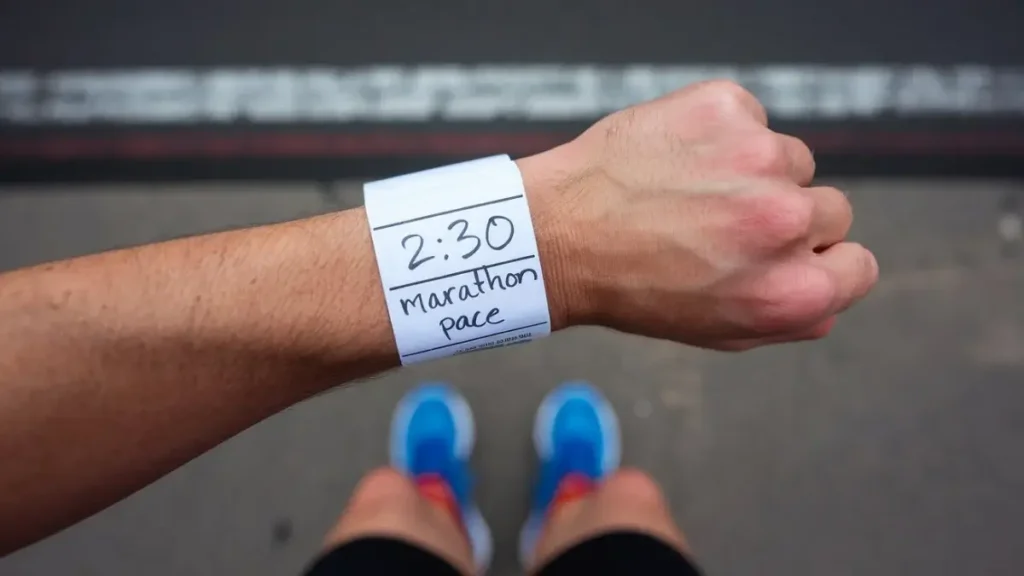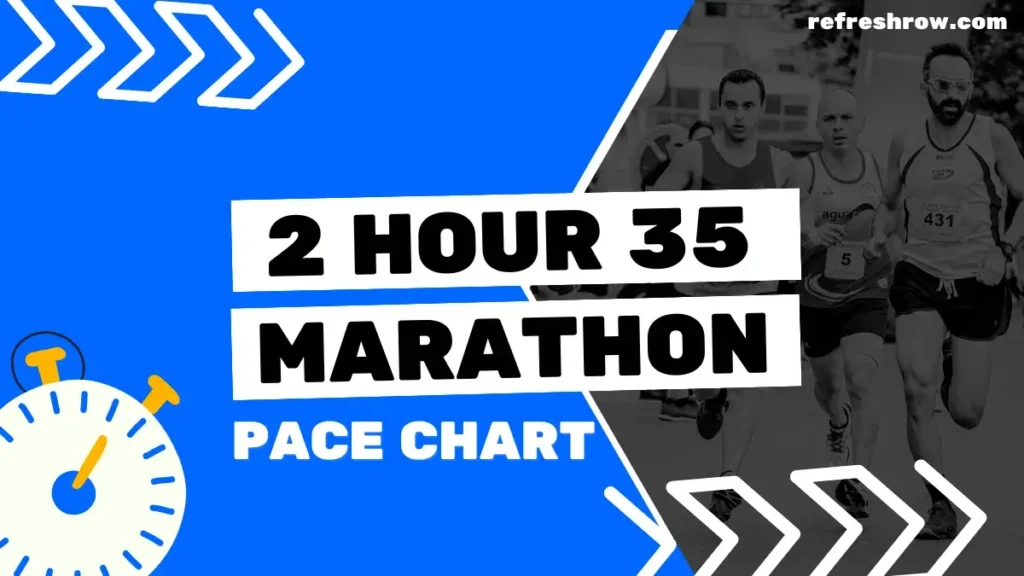To run a 4:50 hour marathon you need to run at a pace of 11:04 per mile or 6:52 per kilometer.
Following the splits below (and shaving off a second), you’ll run a sub 4:50 marathon.
I’d recommend aiming to run 1-2 minutes ahead of the split target time from 10 miles, as you’ll likely come up against crowding on race day.
4:50 Marathon Pace in Miles
| Mile | Split |
|---|---|
| 1 | 11:04 |
| 2 | 22:07 |
| 3 | 33:11 |
| 4 | 44:15 |
| 5 | 55:18 |
| 6 | 1:06:22 |
| 7 | 1:17:26 |
| 8 | 1:28:29 |
| 9 | 1:39:33 |
| 10 | 1:50:36 |
| 11 | 2:01:40 |
| 12 | 2:12:44 |
| 13 | 2:23:47 |
| 14 | 2:34:51 |
| 15 | 2:45:55 |
| 16 | 2:56:58 |
| 17 | 3:08:02 |
| 18 | 3:19:06 |
| 19 | 3:30:09 |
| 20 | 3:41:13 |
| 21 | 3:52:17 |
| 22 | 4:03:20 |
| 23 | 4:14:24 |
| 24 | 4:25:28 |
| 25 | 4:36:31 |
| 26 | 4:47:35 |
| 26.2 | 4:50:00 |
Download
4:50 Marathon Pace in KM
| KM | Split |
|---|---|
| 1 | 6:52 |
| 2 | 13:45 |
| 3 | 20:37 |
| 4 | 27:29 |
| 5 | 34:22 |
| 6 | 41:14 |
| 7 | 48:07 |
| 8 | 54:59 |
| 9 | 1:01:51 |
| 10 | 1:08:44 |
| 11 | 1:15:36 |
| 12 | 1:22:28 |
| 13 | 1:29:21 |
| 14 | 1:36:13 |
| 15 | 1:43:06 |
| 16 | 1:49:58 |
| 17 | 1:56:50 |
| 18 | 2:03:43 |
| 19 | 2:10:35 |
| 20 | 2:17:27 |
| 21 | 2:24:20 |
| 22 | 2:31:12 |
| 23 | 2:38:05 |
| 24 | 2:44:57 |
| 25 | 2:51:49 |
| 26 | 2:58:42 |
| 27 | 3:05:34 |
| 28 | 3:12:26 |
| 29 | 3:19:19 |
| 30 | 3:26:11 |
| 31 | 3:33:04 |
| 32 | 3:39:56 |
| 33 | 3:46:48 |
| 34 | 3:53:41 |
| 35 | 4:00:33 |
| 36 | 4:07:25 |
| 37 | 4:14:18 |
| 38 | 4:21:10 |
| 39 | 4:28:02 |
| 40 | 4:34:55 |
| 41 | 4:41:47 |
| 42 | 4:48:40 |
| 42.2 | 4:50:00 |
Download
Other Marathon Pace Charts
Targeting a different time?
Check out the Full Marathon Pace Chart in Miles or KM
Or select a specific finishing time below:
| 3:00 | 4:00 | 5:00 | |
| 3:05 | 4:05 | 5:15 | |
| 3:10 | 4:10 | 5:30 | |
| 3:15 | 4:15 | 5:45 | |
| 3:20 | 4:20 | 6:00 | |
| 3:25 | 4:25 | 6:15 | |
| 2:30 | 3:30 | 4:30 | 6:30 |
| 2:35 | 3:35 | 4:35 | 6:45 |
| 2:40 | 3:40 | 4:40 | 7:00 |
| 2:45 | 3:45 | 4:45 | |
| 2:50 | 3:50 | 4:50 | |
| 2:55 | 3:55 | 4:55 |
Training for a 4:50 Marathon
Is 4:50 a Good Marathon Time?
Well, what do the stats say?
Run Repeat conducted a study that contains 19,614,975 marathon results from more than 32,335 races across the globe, here is how a 4:50 marathon compares against age and gender for the races recorded:
| Overall | You’re faster than 31.5% of all runners. |
| Male | You’re faster than 22.9% of males. |
| Female | You’re faster than 43.0% of females. |
| <20 | You’re faster than 31.3% of under 20s. |
| 20-29 | You’re faster than 24.3% of 20-29 year olds. |
| 30-39 | You’re faster than 24.3% of 30-39 year olds. |
| 40-49 | You’re faster than 28.3% of 40-49 year olds. |
| 50-59 | You’re faster than 40.3% of 50-59 year olds. |
| >60 | You’re faster than 62.4% of over 60s. |
Training Runs and Paces for a 4:50 Marathon
To break a 4:50 marathon you’ll need to do some serious distance in your training, I recommend at least 10 miles (16km) per week.
You’re also going to need to make sure you’ve crossed off these milestones for other race distances:
- A 5k in 29:55
- A 10k in 1:02:50
- A half marathon in 2:12:00
Training Paces
| Pace | Mins per Mile | Mins per KM |
|---|---|---|
| Easy | 12:28 | 7:44 |
| Steady | 11:04 | 6:52 |
| 10k | 10:08 | 6:18 |
| 5k | 9:44 | 6:02 |
| 1 Mile | 9:02 | 5:38 |
Weekly Mileage Targets
| Target Mileage: | Gradually increase your weekly mileage from 16 miles (26 km) to a peak of 24 miles (39 km). |
| Incremental Increase: | Increase mileage by approximately 10% each week, with every fourth week as a recovery week where mileage is reduced by 20-30%. Make sure to taper for the last 1-2 weeks. |
Long Run Structure
| Total Distance: | Build up to long runs of 16-18 miles (26-29 km). |
| Segment Example: | First 5 miles (8 km): Easy pace, heart rate 140-150 bpm (approximately 13:30/mile or 8:23/km). Next 1 mile (1.6 km): Fast pace at 9:30/mile (5:54/km). Next 5 miles (8 km): Medium effort, heart rate around 160 bpm (approximately 10:30/mile or 6:31/km). Repeat: Repeat the segment twice (5 miles easy, 1 mile fast, 5 miles medium), you can taper the final 2 miles if required. |
Why This Works: Incorporating varied paces within long runs enhances lactate tolerance, which helps on race day when you’ve got to maintain pace despite feeling fatigued. By practicing surges during a run, you can build up your physical and mental resilience (lots of elite marathon runners use these strategies during their training)
Alternating Long Runs: Alternate between structured long runs (easy/fast segments) and easier long runs. For easier long runs, maintain a steady, comfortable pace throughout, focusing on mileage rather than speed to aid recovery.
Speedwork Sessions
| Short Intervals: | – 800m repeats at 4:50 per interval (6:00/km). – Aim for 5-7 repetitions with equal time for recovery. |
| Mile Repeats: | – 1 mile repeats at 9:30 per mile (5:54/km). – Aim for 4-6 repetitions with a 1-2 minute recovery jog. |
| Longer Intervals: | – 2 mile repeats at 9:40 per mile (6:00/km). – Aim for 3-4 repetitions with a 2-3 minute recovery jog. |
Recovery and Rest Days
| Rest Days: | You don’t need to incorporate rest days if you are using recovery runs, but I recommend taking 1 (or a max of 2) per week to allow your body to recover and prevent overtraining. |
| Easy Run Days: | Include 1-2 easy run days per week at a relaxed pace of 13:45/mile (8:32/km), covering 3-5 miles (5-8 km) per day. Try to keep your heart rate below 140 bpm on easy days to ensure proper recovery and aerobic development. |
My Tips to Run a Sub 4:50 Marathon
Perfect Your Hydration and Nutrition Plan
You’re going to be out there for hopefully close to five hours, so it’s really important to get your hydration and nutrition right.
During your long training runs, practice drinking water or sports drinks regularly (20 mins for me) and figure out what works for you.
You’re also going to need to take in some fuel – whether it’s gels, energy chews, or something else – every 30 minutes to an hour.
Experiment lots in training and try all the different types, so you’re not caught off guard on race day.
And remember the golden rule:
NOTHING NEW ON RACE DAY
Train for Mental Endurance in the Last 10K
The mental game becomes critical in the last 10K of a marathon.
And it’s most likely going to make or break you hitting your target.
In your long runs, practice visualization techniques and focus on breaking down the race into smaller, manageable sections – like thinking only about getting to the next mile marker.
Include some mentally tough workouts, like finishing your long runs with faster miles, to simulate the fatigue you’ll experience in the final stretch of the marathon.
The mental stamina you build will help you stay strong when the going gets tough.
Focus on Cadence for Efficiency
Efficient running is key to lasting for nearly five hours, so start paying attention to your cadence (steps per minute).
You can find your cadence on most running apps if you’re using your phone or a sports watch.
Aiming for a cadence of 170-180 steps per minute, even at slower paces, helps reduce the impact on your joints and muscles.
If your cadence is too low, you’re likely over-striding, which can lead to injuries or fatigue.
Practice shorter, quicker steps during your training runs, and you can use a metronome or cadence app to get used to this rhythm.
Improving your cadence will increase your efficiency and make the marathon more manageable.
Build Mental Stamina with “Time-on-Feet” Workouts
One of the key challenges of running a 4:50 marathon is staying mentally engaged for nearly five hours.
Incorporate time-on-feet workouts into your training where the goal is less about distance and more about staying moving for a long period of time.
Aim for 4-hour training runs at a conversational pace, simulating the physical and mental demands of the marathon.
These sessions condition both your mind and body to endure long periods of exertion, which is crucial for tackling the final miles of the race.


Row Brown is the founder of Refresh Row. He is a keen marathon runner, his favorite being the London Marathon. He’s now set himself the mission of Running the Entire Length of Spain, which is scheduled for late 2024.


